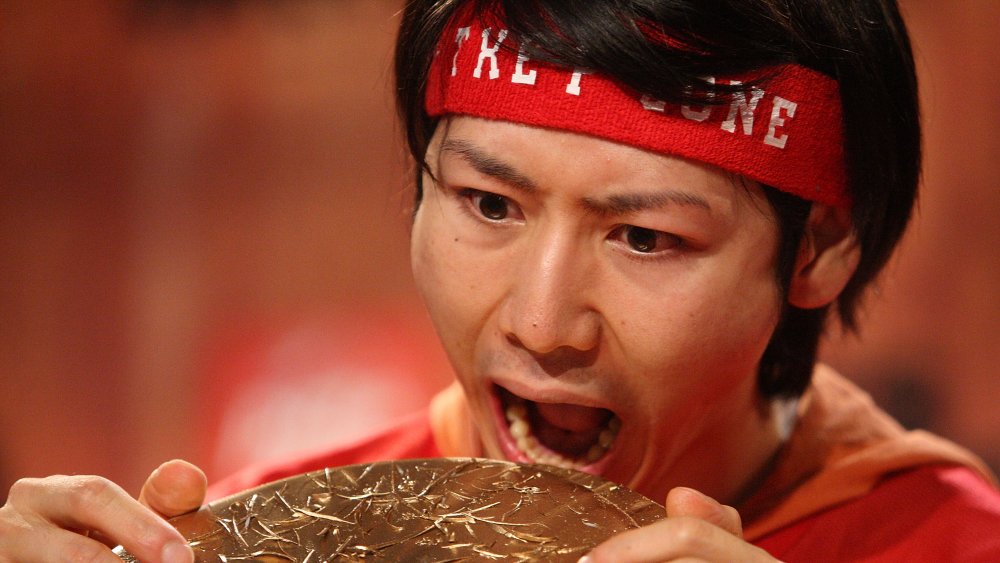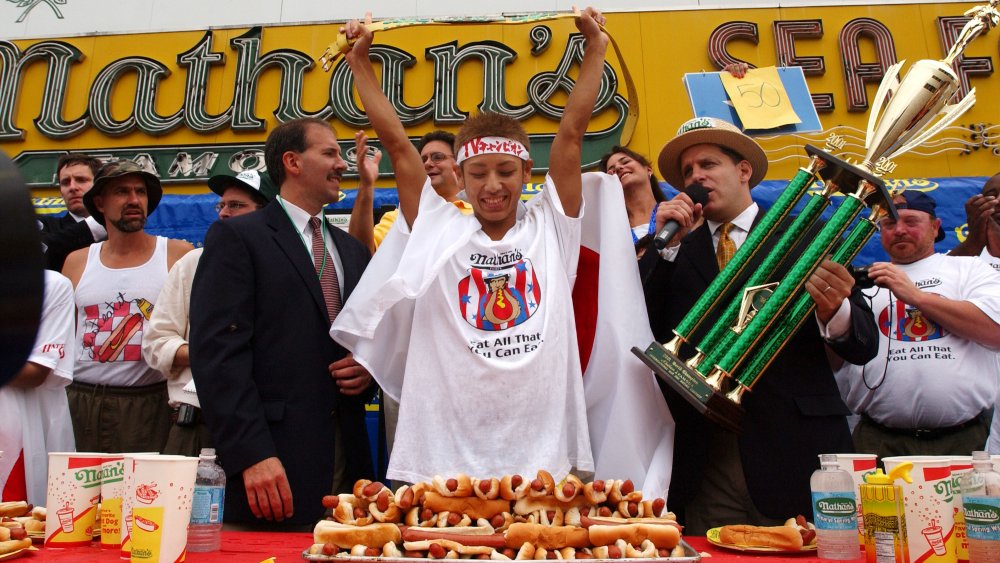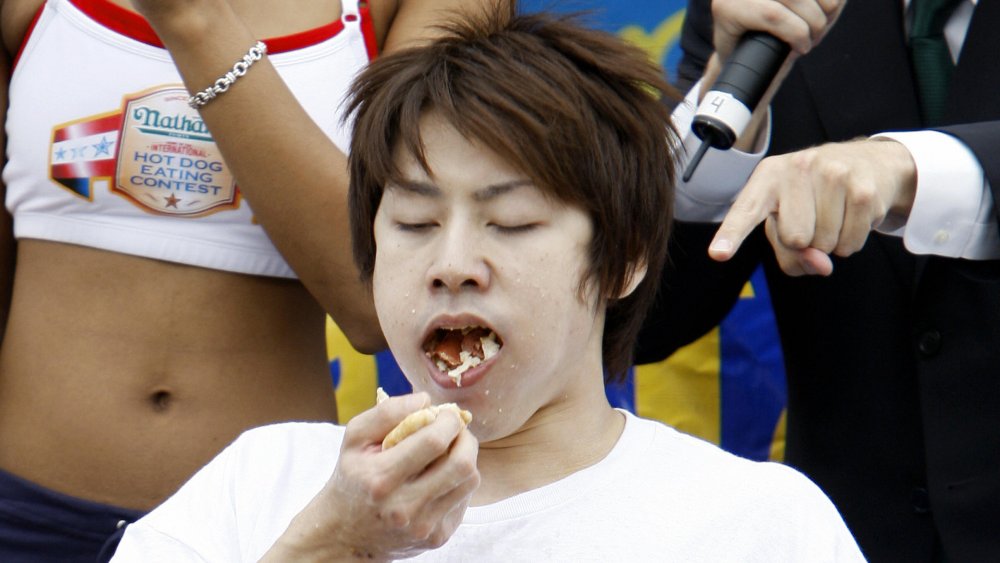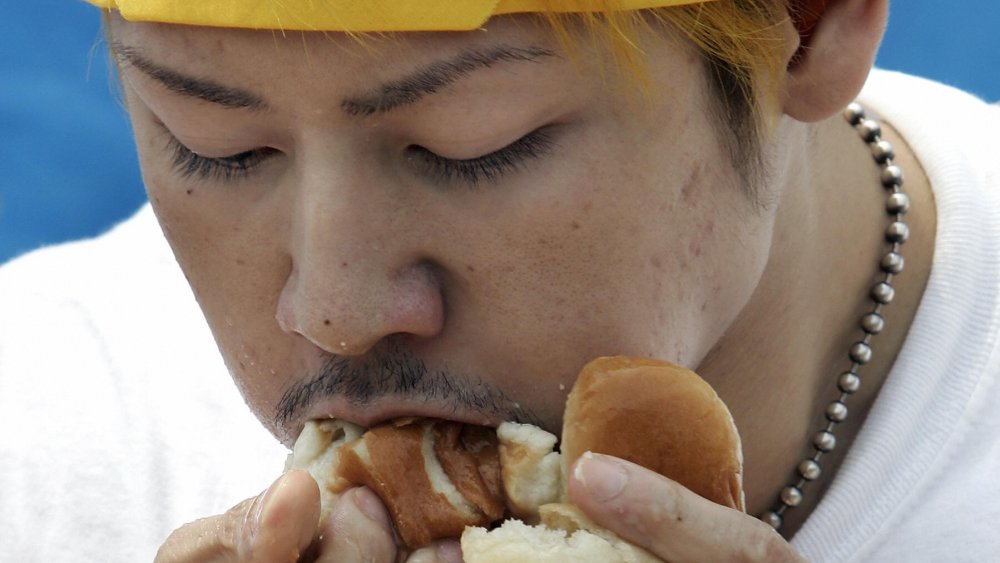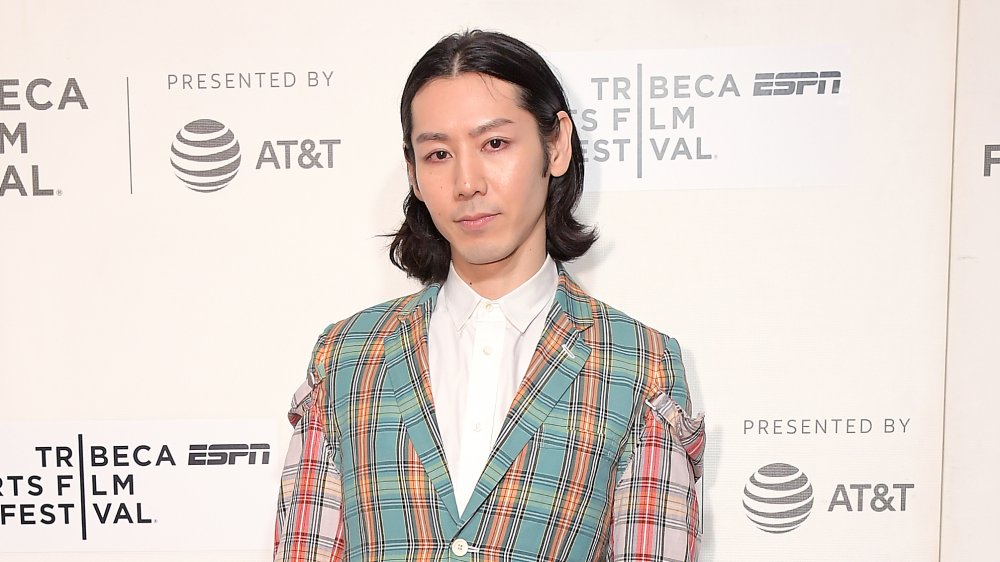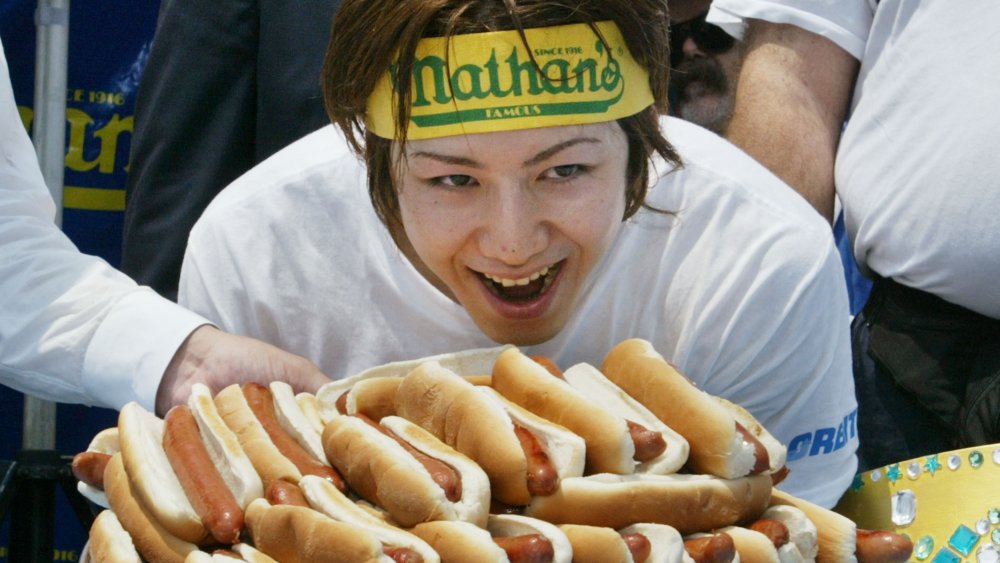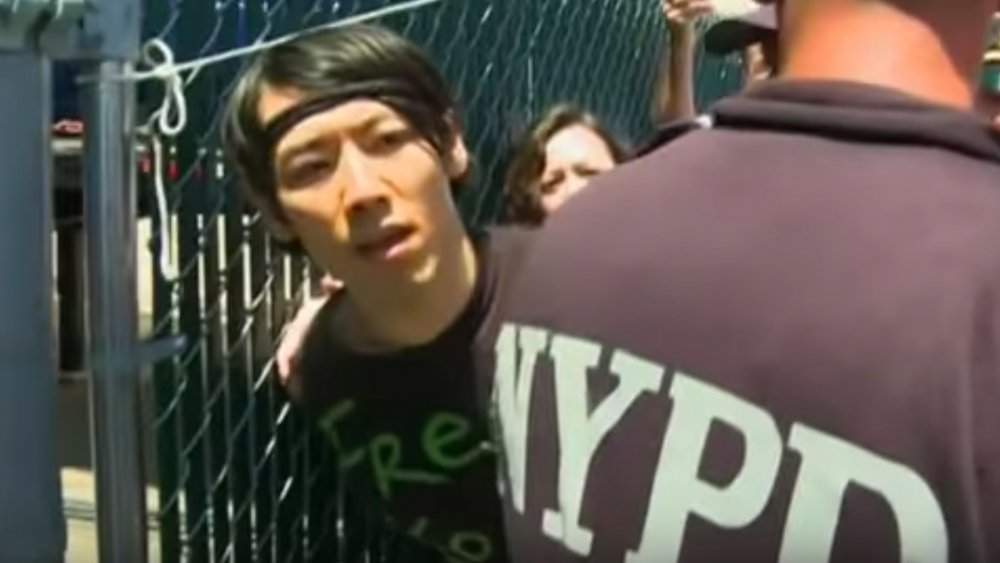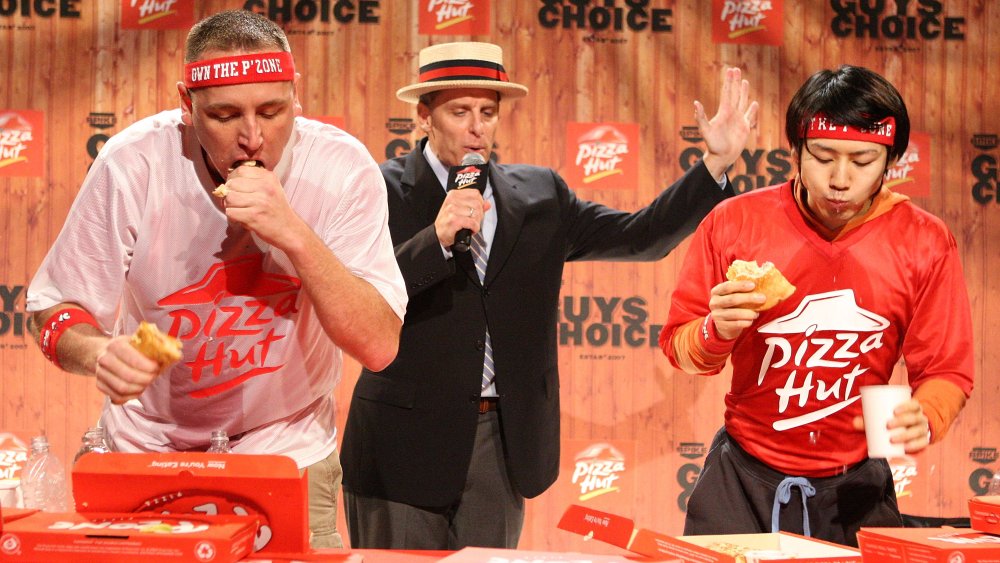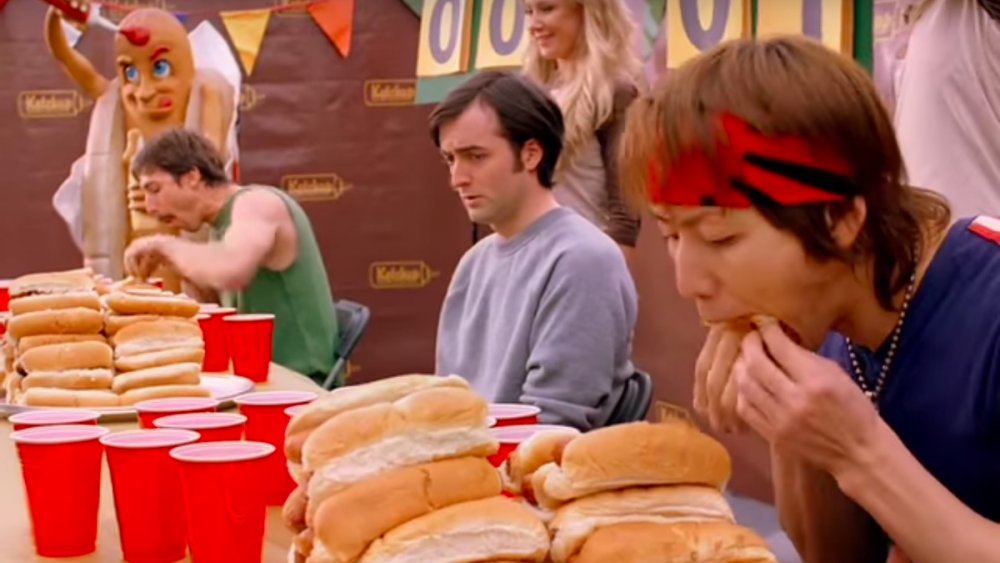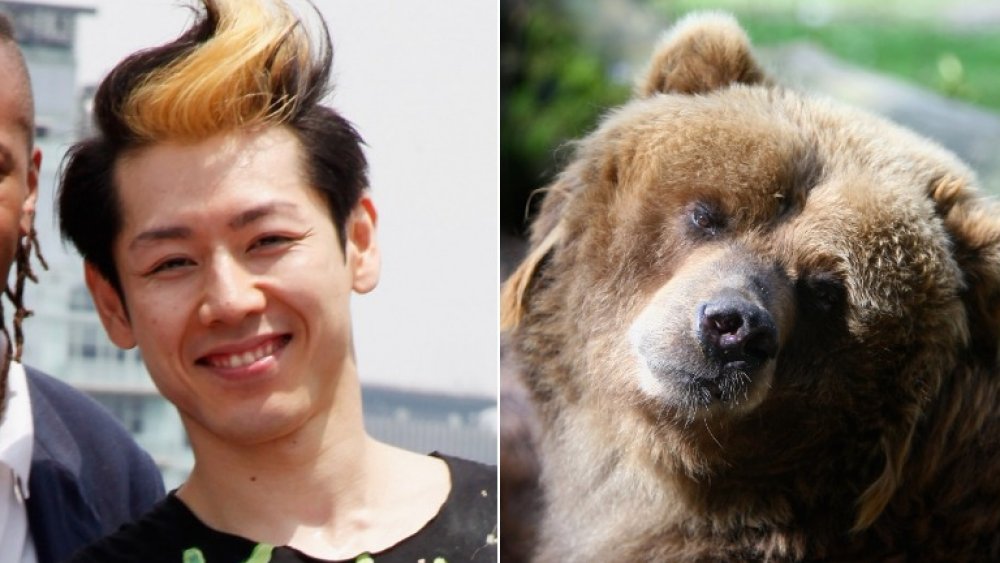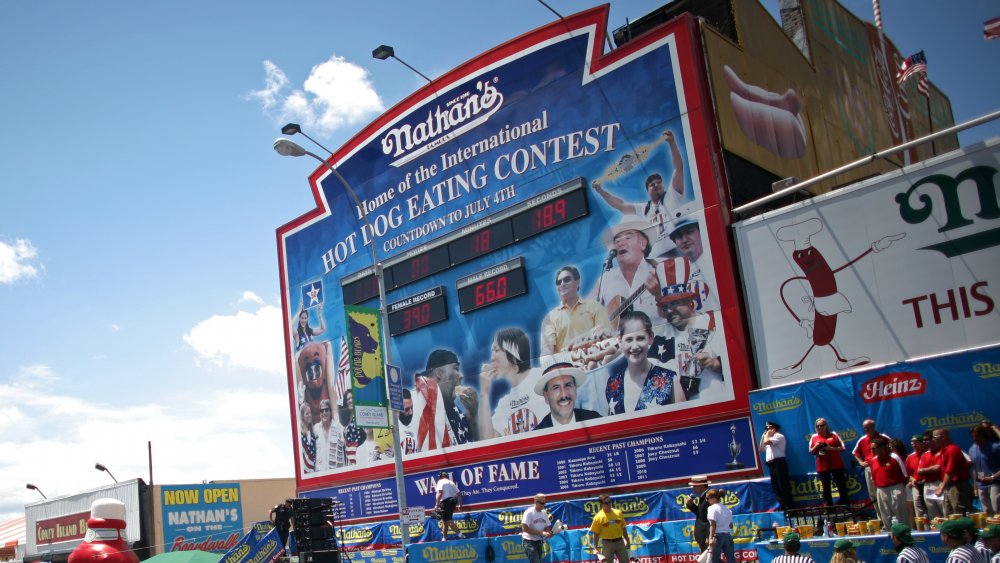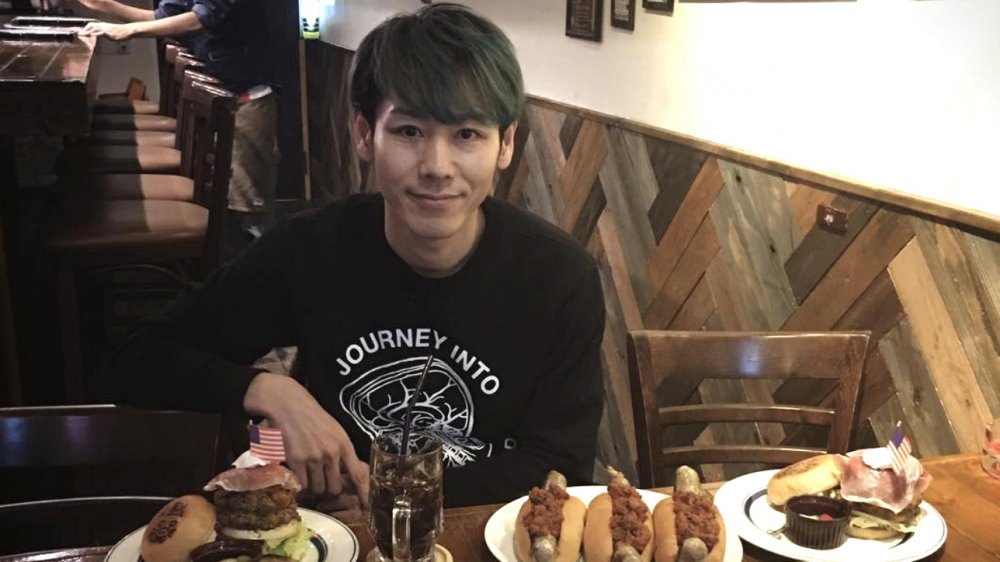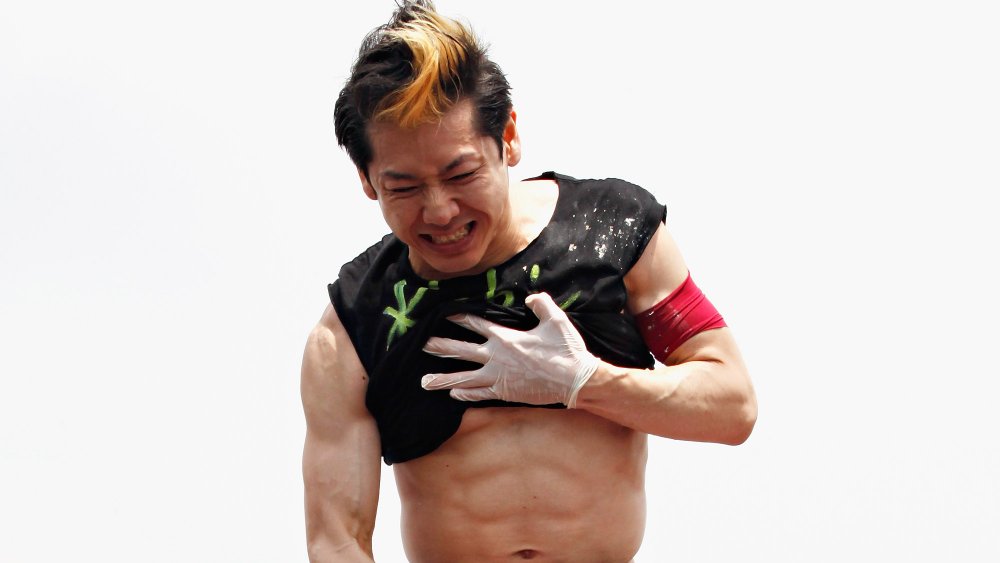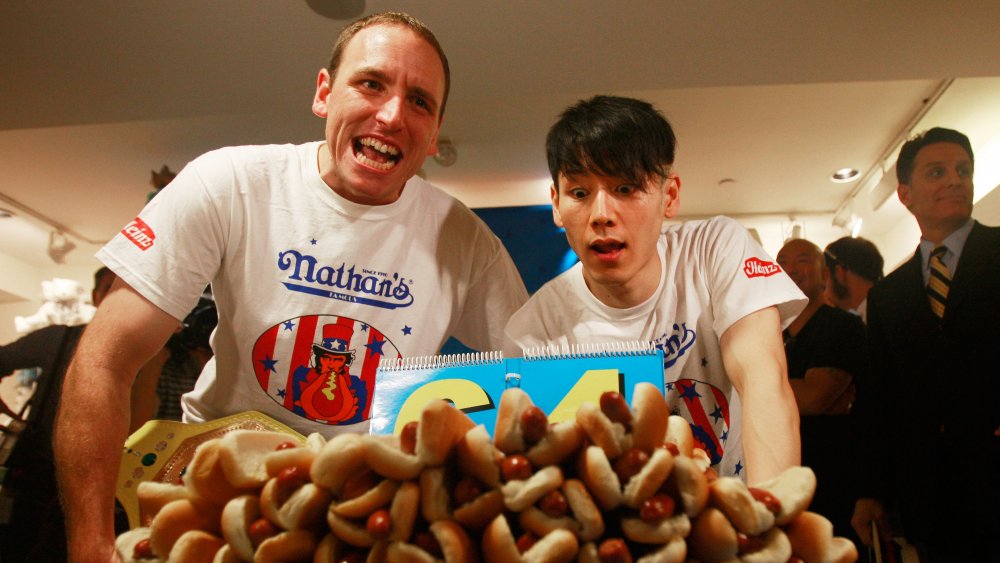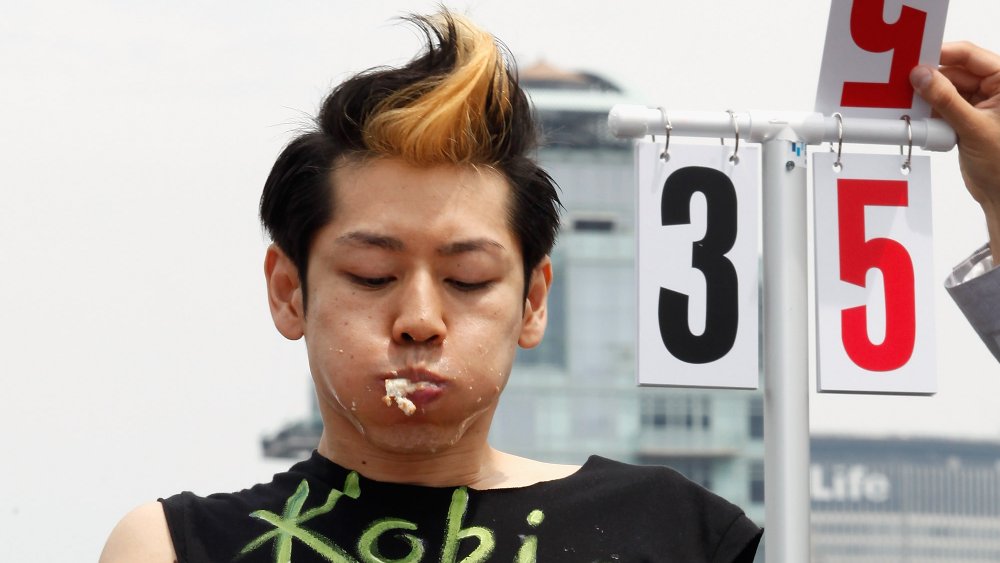The Untold Truth Of Kobayashi
Takeru Kobayashi has become practically synonymous with the world of competitive eating. A native of Nagano, Japan, as reported by The Japan Times, Kobayashi's slight frame has always belied his astounding ability to eat extraordinary amounts of food in ridiculously short periods of time.
According to a 2019 report from Associated Press, Kobayashi holds 15 world records for competitive eating, including Guinness World Records for the most hamburgers consumed in three minutes (12 of them), the most meatballs eaten in one minute (29), and the largest number of Twinkies ever scarfed in one minute (14).
Along with Kobayashi's seemingly unlikely success at this arguably weird endeavor, there has come no shortage of controversy. After winning the Nathan's Famous hot dog eating contest six consecutive times, a long-standing dispute with the Major League Eating organization led to a bizarre arrest and resulted in barring the formidable champion from competing in some of the world's top eating contests. Read on to discover the untold truth of competitive eating legend Takeru Kobayashi.
How Kobayashi changed competitive eating in 2001
Each Fourth of July since 1972, Coney Island hot dog outlet Nathan's Famous has held its iconic hot dog eating contest. In the 2001 edition, a competitor entered the field who changed the game and turned the world of competitive eating on its head.
At first glance, reported CNN at the time, Japanese native Takeru Kobayashi didn't seem like much of a threat, given that the scrawny 23-year-old weighed in at a measly 131 pounds. Yet when the dust settled, Kobayashi had eaten his way to a decisive victory, consuming 50 hot dogs in 12 minutes to double the world record.
In a 2014 interview with the Freakanomics podcast, Kobayashi explained the secret behind his stunning upset. "The key to me was that I had to change the mentality that it was a sport — it wasn't having a meal," he explained. Rather than trying to stuff as many dogs down his gullet as quickly as possible, he developed the odd-but-effective technique of dipping the hot dog bun in water to break down the starch, squeezing out the excess moisture and then eating these little bun balls separately from the wieners.
The health woes Kobayashi experienced from competitive eating
It's no secret that competitive eating isn't a normal way to consume a meal. As a result, cramming that much food into one's body during such a compressed period of time can carry some serious health risks. Competitive eating, reported USA Today, can result in such health woes as gastric ruptures and can even lead to seizures triggered when sodium levels drop dangerously low.
Meanwhile, a 2007 study entitled "Competitive Speed Eating: Truth and Consequences" published in the American Journal of Roentgenology concluded that competitive eaters were likely to develop such maladies as "morbid obesity, profound gastroparesis, intractable nausea and vomiting, and even the need for a gastrectomy."
While Takeru Kobayashi hasn't experienced any of those health problems, he has encountered some issues from his competitive eating and the training required, including exhaustion and shortage of breath. The latter, he explained in an interview with Associated Press, occurred when his stomach became so full that it caused organs to shift inside his body, with his lungs pushed up so high by his bloated belly that there was no room for the lungs to expand. "So, when I breathe, I become very short of breath," he explained.
Kobayashi was almost sidelined due to an arthritic jaw
While Takeru Koyabashi had been able to avoid many serious health difficulties brought on by years of competitive eating, he didn't emerge entirely unscathed. In 2007, in fact, there were fears he might not be able to compete in that year's edition of the Nathan's Famous hot dog eating competition when he was diagnosed with arthritis in his jaw.
As People reported at the time, Kobayashi shared the news on his website, writing that his "jaw refused to fight anymore" and had "abandoned the frontline." He indicated that he was unable to "open my jaws more than just a little bit," while widening his mouth just enough to stick in the equivalent of more than one finger was "painful."
Despite the discomfort from his arthritic jaw, Kobayashi soldiered on and competed. While it's difficult to determine how much of a factor his jaw problem played, Kobayashi wound up losing. American competitor Joey Chestnut was declared the victor, ending Kobayashi's six-year winning streak when Chestnut was able to cram an impressive 66 hot dogs down his throat.
Kobayashi was granted a hard-to-get U.S visa for "extraordinary ability"
The United States government will occasionally grant a foreigner a O-1 visa, a difficult-to-obtain document that is only given to individuals who demonstrate "extraordinary ability or achievement." These special visas allow the foreign-born folks to live and work in the U.S. for an extended period of time, and they are doled out sparingly. According to federal regulations, a successful applicant must possess "extraordinary ability in the sciences, arts, education, business, or athletics," or have made an "extraordinary achievement in the motion picture or television industry" that has been "recognized nationally or internationally."
Apparently, being able to eat insane amounts of food somehow fits the bill as an "extraordinary ability." In 2010, reported Canada's National Post, Takeru Kobayashi declared that he had obtained an O-1 visa, so he could work in the U.S. Regarding his exceptional skill, he shared, "In my case that ability was competitive eating."
The truth behind Kobayashi's dispute with Major League Eating
As Takeru Kobayashi continued to dominate Nathan's Fourth of July competitions, his incredible victories propelled the popularity of Major League Eating (MLE). The organization ran contests for Nathan's and other sponsors. In 2010, reported The New York Times, a rift formed when Kobayashi balked at the league's exclusivity contract that he and other competitors were required to sign in order to compete in events sanctioned by Major League Eating.
"They want complete control over me," Kobayashi complained to the New York Daily News, noting the contract prohibited him from competing in non-MLE events. "I just want to compete and do what I love. They are trying to take away my freedom."
The National Post revealed details of that contract, which illuminated Kobayashi's reluctance to sign. According to the Post, the contract restricted the ability to earn any money from outside the MLE. In addition, the MLE was also deemed "exclusive representative" for its "performers" to negotiate any "revenue opportunities" such as advertising, film, TV, and endorsement deals, with the eaters required to pay "20 percent of the gross amounts to the league."
Kobayashi was once arrested at a hot dog eating contest
When Takeru Kobayashi refused to sign a contract with Major League Eating in 2010, he was barred from competing in that year's Nathan's Famous Fourth of July hot dog eating competition. As Kobayashi told the New York Daily News ahead of the event, he was hopeful something could be worked out. "I want to be in it more than anything. I am hoping they will change their mind," he said. "If I compete, I guarantee I'll win."
Ultimately, no deal was reached, and Kobayashi was not allowed to compete — which is when things took a very weird turn. Kobayashi may have been banned from competing, but he still showed up as a spectator. Speaking with ESPN, Kobayashi said that fans at the event began chanting for him, which spurred him to jump onstage "in the heat of it," hoping that officials would relent and allow him to compete "to prove that I am still the champ," he explained.
Instead, he was arrested, and he faced charges of "obstruction of governmental administration, resisting arrest, trespassing, and disorderly conduct." About a month later, reported Reuters, a judge dismissed all charges.
Kobayashi's rivalry with Joey Chestnut inspired a sports documentary
Throughout his career in competitive eating, Takeru Kobayashi's primary rival has been Joey Chestnut. Nicknamed "Jaws" for his prodigious ability to stuff his face faster than just about anyone on the planet, Chestnut emerged as a force to be reckoned with on the competitive eating scene, earning several world records of his own. As it turned out, he was one of the few to be able to give Kobayashi a run for his money, winning Nathan's "Mustard Belt" multiple times.
And thus emerged one of the most heated — and, to be honest, most bizarre — pseudo-sports rivalries of all time. In fact, ESPN thought the whole thing was fascinating enough to serve as the basis for one of its 30 for 30 sports documentaries.
In July 2019, ESPN released The Good, The Bad, The Hungry. While the film focused on his rivalry with Chestnut, Kobayashi told The Japan Times that he actually "had more of a problem with [Major League Eating co-founder] George Shea," noting, "He used Joey Chestnut to conceal the fact that he had a problem with me."
Kobayashi ate his way into commercials for MasterCard, Coors Light, and more
Takeru Kobayashi's prowess at eating ridiculous amounts of food in a very short period of time brought him a certain degree of fame, which led to him being hired in TV commercials for an array of products. In 2007, for example, a commercial for MasterCard's Priceless.com campaign featured him calmly stuffing an entire hot dog into his mouth while classical piano music tinkled in the background. He also appeared in another MasterCard commercial in which he faced off in a convenience store hot dog eating contest with fellow competitive eater Sonya "The Black Widow" Thomas.
That same year, he also appeared in a spot for Coors Light, entering a bar and causing the nervous bartender to quickly erase an "All You Can Eat" sign from a chalkboard. He also appeared in a commercial for the Western Canada Lottery Corporation, and starred in a clever spot for sports marketing firm Thuzio, with Twinkies used to lure him into a meeting with the company's co-founder, NFL great Tiki Barber.
Kobayashi once lost an eating challenge to a bear
Takeru Kobayashi proved to be a formidable opponent against his fellow humans, but how would he fare in an eating challenge that pitted him against a member of an entirely different species? TV viewers found out in 2003 when Kobayashi appeared on Fox's Man vs. Beast, a series of bonkers specials that pitted extraordinary people against various animals in weird competitions.
During the course of the specials, viewers watched such events as a Sumo wrestler attempting to win a tug of war with an orangutan and a sprinter racing a zebra. In his segment, Kobayshi faced off against a 1,089-pound Kodiak bear in a hot dog eating contest.
Kobayashi's technique, which had led him to so many victories, proved to be no match for the bear. Despite, of course, not even realizing it was competing in a contest, the bear was still hungry enough to inhale more hot dogs than Kobayashi did. After his loss, Kobayashi said he would like another shot at taking on the animal, but did admit via his translator that he "was very scared of the big, big bear."
The surprising reason Nathan's removed Kobayashi from its Wall of Fame
While charges against Takeru Kobayashi stemming from his 2010 arrest were ultimately dismissed, his contract dispute with Major League Eating remained unresolved. Nathan's had a longstanding relationship with George and Richard Shea, the brothers who founded the organization, with the pair initially handling the company's public relations efforts before founding MLE.
Even though he could no longer compete in the annual Fourth of July hot dog eating extravaganza, Kobayashi remained a six-time world champion. However, this, reported Brooklyn Paper, didn't prevent Nathan's from removing the competitive eating pioneer from its Wall of Fame on the Coney Island boardwalk.
MLE's George Shea denied that Kobayashi's removal was a retaliatory strike for his refusal to sign an exclusivity contract with the group. "Kobayashi actively removed himself from the world of professional eating and as a result, we must make room for those who will continue to engage in professional eating," Shea told the media outlet. "We did not drive him away. He changed what he wanted." Kobayashi disagreed. "Images can be taken off the wall, but I hope the history stays with the memories the people have," he responded.
Kobayashi weighed in on the is-a-hot-dog-a-sandwich debate
At some point in the late 2010s, a bizarre years-long debate engulfed the internet to address a surprisingly provocative question: Is a hot dog a sandwich? There were those who insisted that, because it was essentially meat that was "sandwiched" inside a bun, a hot dog was indeed a type of sandwich. Others, however, maintained that a hot dog is its own specific entity and is absolutely not a sandwich.
If there's one person who could arguably be called a hot dog expert and who could settle this question once and for all, it's competitive eating icon Takeru Kobayashi. Given his six consecutive wins at Nathan's Fourth of July hot dog eating contests and the thousands upon thousands of hot dogs he's consumed over the years, he was asked to weigh in on the debate by Bleacher Report.
So does Kobayashi think a hot dog is a sandwich? "No! No," he declared. "You have to have a lot of respect for hot dogs. It's completely different." The way Kobayashi viewed it, "a hot dog is like a pop idol," noting, "Everyone knows what a hot dog is."
The surprising way Kobayashi trains for his competitive eating challenges
While it would be easy to assume the best way to train for a competitive eating challenge would be by eating as much as humanly possible as often as possible, the truth is that strategy is more likely to result in a hospital visit with My 600-lb Life's Dr. Now than win any eating contests.
In fact, Takeru Kobayashi works out as hard as any athlete when he trains for a competition. According to an interview with Weight Watchers, Kobayashi revealed that he would hit the gym three times a week for weight-training sessions that left him with rippling six-pack abs and bulging muscles. His ideal competition weight, he revealed, is 132 pounds. "I love lifting," he admitted. "That's always where I'm most focused."
There is one more key element to his training: water and lots of it. "I have to put something inside the stomach to make it expand, but it doesn't necessarily have to be food. I train with water," he explained to People. "So, I'm not training for long periods of time by hauling food. I'm training with water expanding my stomach."
Kobayashi accused rival Joey Chestnut of cheating
Professional sports is rife with bitter rivalries, and, in the world of competitive eating, there's no rivalry more intense or long-lasting than the one between Takeru Kobayashi and Joey Chestnut. Kobayashi, after all, revolutionized competitive eating, winning Nathan's Famous Fourth of July hot dog eating competition for six consecutive years until getting toppled by Chestnut.
While there's no love lost between the two competitors, Kobayashi leveled a big allegation against Chestnut when he accused him of cheating. In a 2019 interview with TMZ, Kobayashi was asked about Chestnut's ever-increasing numbers, having once consumed a record-setting 74 hot dogs. "It is questionable that the size of the hot dogs are even the same from ten years ago," Kobayashi said through his interpreter.
Responding to claims that Chestnut had been cheating by not eating all the food, Kobayashi replied, "I've personally, definitely witnessed some cheating, yes." He cited an example from a pizza eating contest years earlier, claiming he witnessed Chestnut "throwing the hardest part to eat — the crust — into the box the whole time."
Why Kobayashi's true skills are mental, not physical
There's no doubt that Takeru Kobayashi's competitive eating skills are based on his physical ability to consume more food than his competitors. However, the authors behind the Freakonomics books, website, and podcast believe that Kobayashi's true achievements lie with his mental abilities to think outside the box.
In an excerpt from their book Think Like a Freak, published in The Guardian, authors Stephen J. Dubner and Steven Levitt analyzed the thought process that led Kobayashi to develop his signature move: separating the dog from the bun, drenching the buns in water, squeezing out the excess liquid, and eating bun and wiener separately.
Kobayashi's technique was a game-changer; as a result, the authors claimed, his actual success wasn't that he could eat more hot dogs than anyone else, but that he redefined the problem he was attempting to solve. Rather than tackle the obvious question — how to eat more hot dogs — he looked for solutions to a different problem: how to make hot dogs easier to eat. Solving the second problem took care of the first, allowing him to double the existing record.
